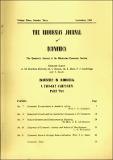| dc.contributor.author | Sadie, Jan L. | |
| dc.coverage.spatial | Zimbabwe | en |
| dc.coverage.spatial | Rhodesia | en |
| dc.date.accessioned | 2015-08-10T08:34:21Z | |
| dc.date.available | 2015-08-10T08:34:21Z | |
| dc.date.issued | 1969-09 | |
| dc.identifier.citation | Sadie, J.L. (1969) Economic Growth through Industrialisation. Rhodesia Journal of Economics, vol.3, no.3, (pp. 42-56.) UZ (formerly University of Rhodesia), Harare (formerly Salisbury) : RES. | en |
| dc.identifier.uri | https://opendocs.ids.ac.uk/opendocs/handle/20.500.12413/6699 | |
| dc.description | A RJE conference paper on economic growth by way of industrialization in the then Rhodesia (now Zimbabwe). Paper Presented at the Symposium for Industry In Rhodesia, June 11th-12th, 1969. | en |
| dc.description.abstract | Arising from the experience of the pioneers of industrialisation, who have become the twentieth century’s highly industrialised states, high rates of longterm economic growth have come to be, not only associated with, but attributed to, the development of the manufacturing sector whose contribution to the Gross Domestic Product (G.D.P.) has shown very considerable increases over periods of decades in these countries. The development involved relative and absolute shifts in the allocation of economic resources among the various economic sectors which, for ease of exposition, can be classified into the three broad categories of primary, secondary and tertiary industries. The available evidence in this connection would suggest the following general pattern:
(a) the share of the primary sector in the use of labour and capital in the developed economies diminished to approximately the same extent as its share in G.D.P., so that its productivity would have increased at the same rate as that of the economy as a whole;
(b) the share of the secondary sector in G.D.P. grew more rapidly than its share in economic resources, and that its productivity must have risen at rates considerably higher than that of the entire economy;
(c) while the situation with respect to the tertiary sector is not easily identifiable it seems justified to conclude that its share in the use of economic resources increased more rapidly than its contribution to total product, so that its productivity must have grown at a lower rate than that of the economy in the aggregate. | en |
| dc.language.iso | en | en |
| dc.publisher | Rhodesian Economic Society (RES). University of Rhodesia (now University of Zimbabwe.) | en |
| dc.rights.uri | http://creativecommons.org/licenses/by-nc-nd/3.0/ | en |
| dc.subject | Economic Development | en |
| dc.subject | Industrial Development | en |
| dc.title | Economic Growth through Industrialisation | en |
| dc.type | Conference paper | en |
| dc.rights.holder | University of Zimbabwe (UZ) (formerly University College of Rhodesia) | en |


